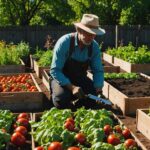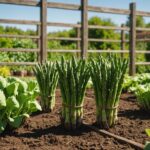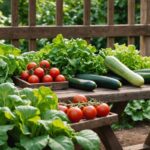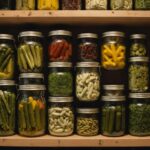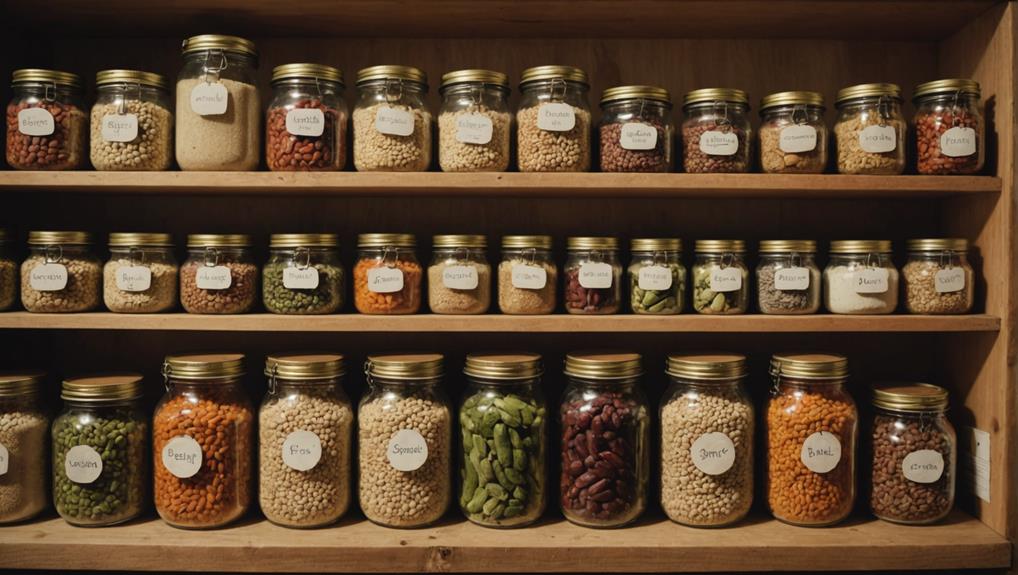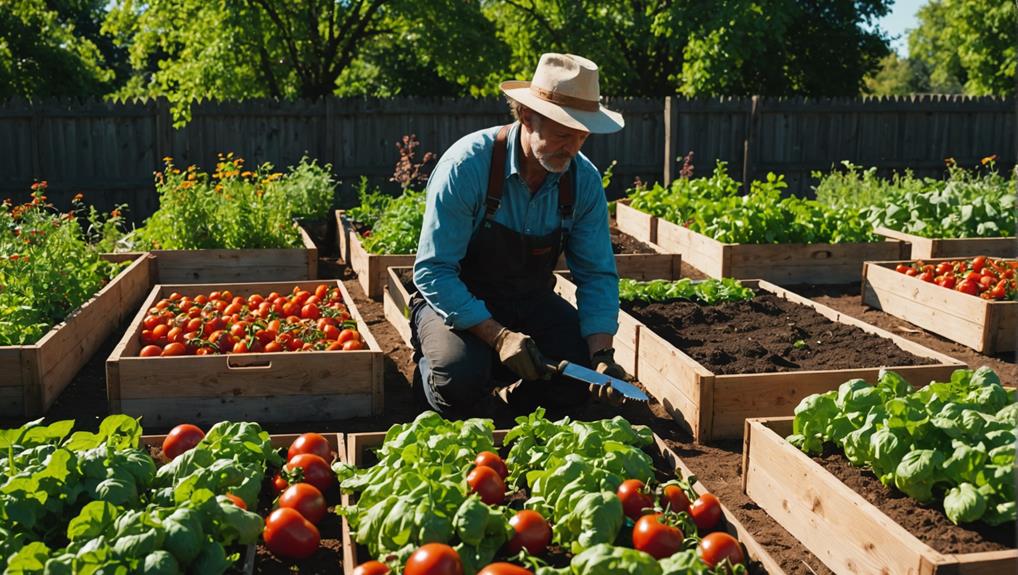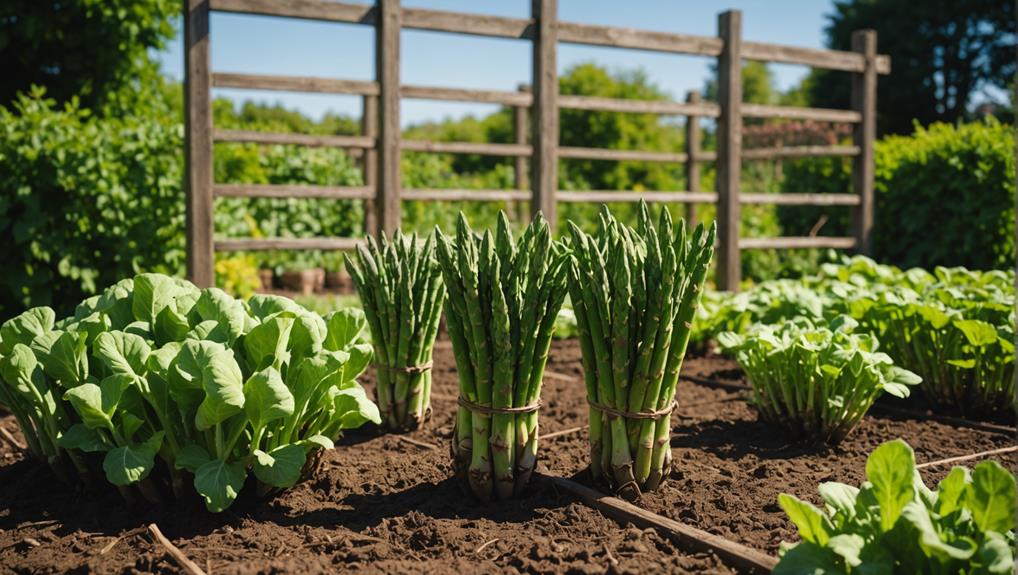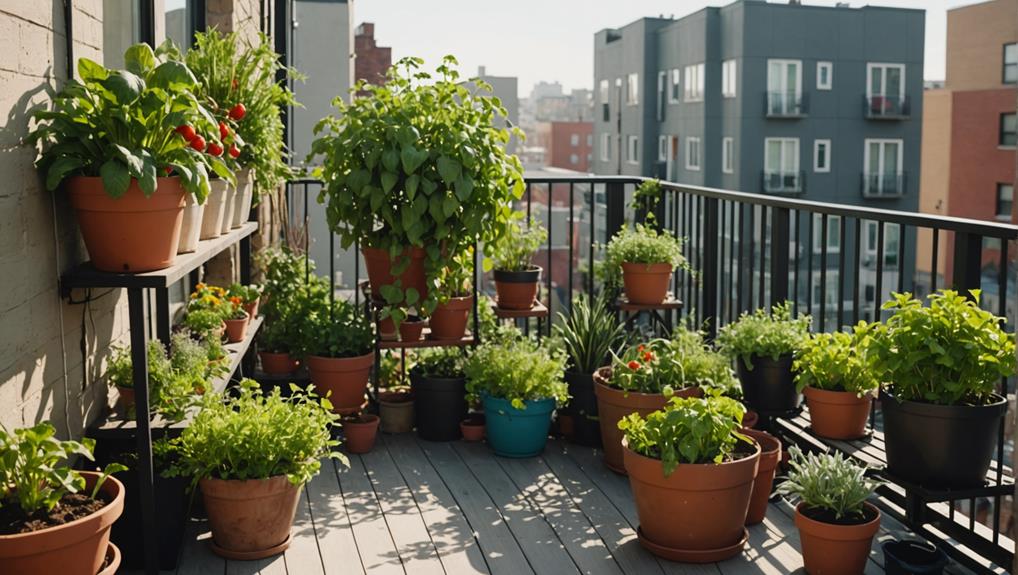As an Amazon Associate I earn from qualifying purchases.
To store food for the long haul, focus on shelf-stable items like grains, legumes, and canned goods. Buy in bulk, but start small to avoid waste. Use food-grade mylar bags with oxygen absorbers and keep everything in a cool, dark place to extend shelf life. Don't forget to regularly check expiration dates and rotate your stock using the FIFO method. Plan for diverse options to meet nutritional needs. With these strategies, you can build a solid emergency pantry. Curious about more detailed tips and techniques? There's plenty more to explore to guarantee your preparedness.
Importance of Long-Term Food Storage
Long-term food storage is essential for your family's food security during emergencies, allowing you to depend less on grocery stores and more on your own supplies. By focusing on shelf-stable foods with a lifespan of at least one year, you can create a resilient pantry that minimizes waste and maximizes your nutritional options. Stocking up on bulk food, like grains and legumes, guarantees you have a solid foundation for any situation that may arise.
Proper food safety practices are critical in this process. When you store bulk foods in 5-gallon buckets with oxygen absorbers, you're revealing the potential for items to last up to 30 years. This is a game-changer for preppers who prioritize independence. However, remember to rotate your emergency foods regularly—canned goods should be checked and replaced every 2-4 years to maintain ideal quality.
Establishing a diverse range of food types boosts your chances of staying nourished during extended emergencies. Embrace the freedom that comes with being prepared; long-term food storage empowers you to take control of your family's food supply and security.
Essential Food Types
Stocking up on the right types of food is key to building a dependable and versatile pantry for any emergency situation. Start with grains like rice, pasta, and oats; they're long-lasting and adaptable for various meals. Next, consider legumes such as beans and lentils. They're not just budget-friendly but also packed with protein and fiber, making them a smart choice for your food supply.
Don't overlook canned goods. Items like vegetables, fruits, and meats are convenient and can last for years when stored properly. Remember, high-acid foods like tomatoes have a shorter shelf life, so plan accordingly.
Include a selection of dry goods and non-perishable foods too. Fats like canned meats and textured vegetable protein (TVP) can be essential for both nutrition and cooking. Finally, stock up on spices and baking essentials—salt, sugar, and baking powder can elevate your meals and provide comfort, even during tough times.
Smart Shopping Strategies
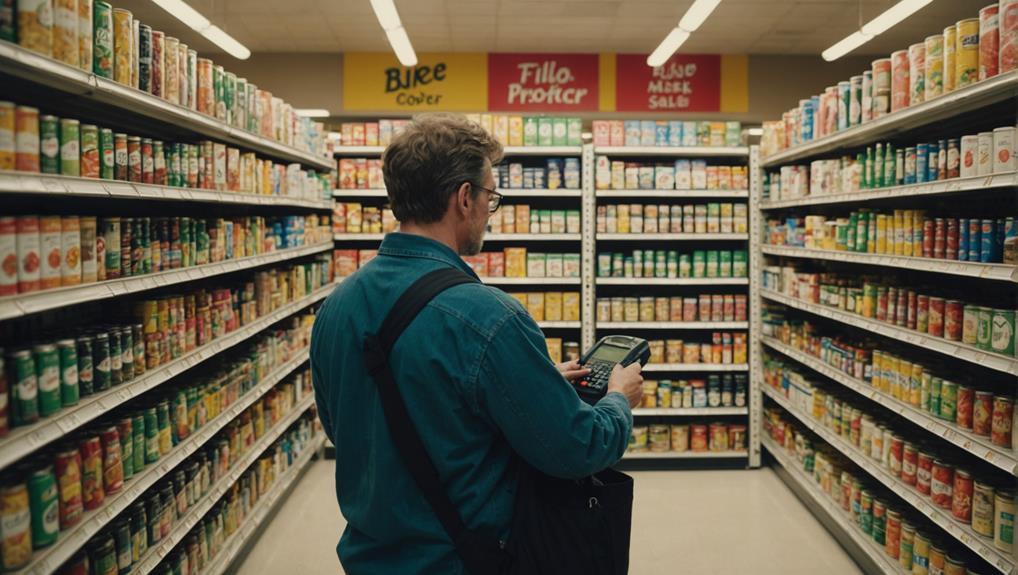
When you shop for long-term food storage, smart strategies can save you money and reduce waste. Buying in bulk can be beneficial, but it's essential to test smaller quantities of unfamiliar items first. You'll also want to avoid mega-packs that may not fit your family's needs, ensuring you stock up wisely.
Bulk Purchasing Benefits
Buying food in bulk can be a smart shopping strategy that not only cuts costs but also guarantees you have the right items on hand for your needs. When you embrace bulk purchasing, you can enjoy significant savings—sometimes up to 50%—compared to buying individual items. This approach also supports your freedom to stock up on essentials for long-term storage without breaking the bank.
To maximize your food storage efficiency, consider effective strategies like taking advantage of sales and coupons. This not only enhances your savings but assures you're getting quality options for long-term use. Focus on purchasing items that you regularly consume, allowing you to minimize waste and spoilage. By customizing your bulk purchases rather than opting for mega-packs filled with unwanted goods, you can guarantee that only desirable products fill your pantry.
Testing Small Quantities
Testing small quantities of food before committing to bulk purchases helps guarantee you're choosing items your family will actually enjoy. By starting with smaller packages, you can avoid the pitfalls of unwanted flavors and textures that often come with larger bulk buys. This approach not only minimizes waste but also assures that your food storage is filled with regularly consumed foods that fit your family's dietary preferences.
Consider implementing a trial period for new items. This way, you can evaluate their practicality and convenience without overwhelming your pantry. Smaller jars or packages allow for easier rotation, keeping your stock fresh and ready for use. Plus, when you focus on customized items that suit your needs, you're likely to save money in the long run—think about how a $410 mega-pack can pale in comparison to a tailored selection costing just $211.
As you navigate your food storage strategy, remember that testing small quantities empowers you to make informed choices, guaranteeing your stockpile is not only sustainable but also enjoyable for your family. Embrace this method to enhance your prepping experience, promoting both freedom and efficiency in your food preparations.
Avoiding Mega-Packs
Embracing smart shopping strategies means steering clear of mega-packs that often lead to waste and unwanted items in your pantry. Instead, focus on buying foods in smaller quantities that align with your regular diet. This way, you can save money and reduce the risk of spoilage. Testing small quantities helps you determine if a food meets your taste preferences, ensuring you won't end up with ingredients you never use.
Opting for individual item purchases not only cuts costs, sometimes by nearly 50%, but also allows for easier storage, particularly for perishable items. When you prioritize foods with long shelf lives, you're setting yourself up for success in stocking your emergency supplies. You want items that are easy to prepare and maintain their quality over time.
Effective Food Storage Techniques
When you're prepping, effective food storage is essential for maximizing your supplies. You'll want to understand the benefits of bulk purchasing, ideal storage conditions, and how to practice food rotation. These techniques not only preserve your food but also guarantee you're ready for any situation.
Bulk Purchasing Benefits
Bulk purchasing considerably reduces costs, making it an efficient strategy for preppers looking to build a sustainable food supply. By acquiring bulk staples like grains and legumes, you guarantee a steady flow of essential nutrients while cutting down on your reliance on grocery stores during emergencies.
To maximize your investment, consider using food-grade mylar bags with oxygen absorbers for long-term storage. This method can extend the shelf life of your bulk items for up to 30 years, giving you peace of mind that your food supply is secure. Testing small quantities before committing to larger purchases can also help you avoid waste and guarantee that the foods align with your family's preferences.
Don't forget to store bulk items in smaller jars or packaging to prevent spoilage and make it easier to access frequently consumed foods. By adopting these strategies, you not only save money but also gain the freedom to take control of your food supply, guaranteeing you're prepared for whatever life throws your way. Embrace bulk purchasing, and you'll be well on your way to long-term food security.
Optimal Storage Conditions
To guarantee your food supplies last as long as possible, store them in cool, dark, and dry places that minimize exposure to heat, light, and moisture. Properly stored food can greatly extend shelf life, ensuring you're ready for anything. Using airtight containers, like mylar bags with oxygen absorbers, is essential to protect dry goods from pests and oxygen, which can compromise food safety.
Here's a quick reference table to help you visualize ideal storage conditions:
| Food Type | Ideal Storage Temperature | Expiration Date |
|---|---|---|
| Canned Goods | 50-70°F (10-21°C) | 2-4 years |
| Dry Grains | 50-70°F (10-21°C) | 5-10 years |
| Freeze-Dried Food | 50-70°F (10-21°C) | 25+ years |
| Dehydrated Foods | 50-70°F (10-21°C) | 5-10 years |
| Nuts & Seeds | 32-70°F (0-21°C) | 6 months-2 years |
Regularly inspect your supplies for signs of spoilage and stay vigilant about expiration dates. With these ideal storage conditions, you can maintain your freedom and preparedness.
Food Rotation Practices
Implementing effective food rotation practices is vital for maximizing the freshness and longevity of your emergency supplies. Start by using the FIFO method—First In, First Out. This guarantees you consume older items before newer ones, reducing waste and keeping your stock tasty.
Regularly inspect food containers for signs of spoilage. Look for bulging or rust in canned goods; these are red flags that could indicate spoilage. Remember, while commercially canned foods can last, their flavor may diminish over time, so rotate them every 2-4 years to maintain quality.
For dry ingredients like grains and legumes, store them in clean, dry, dark areas to prolong their shelf life. Keeping a detailed inventory of your stored foods is essential. Note expiration dates and prioritize consuming items nearing their end of shelf life.
Water Storage Solutions
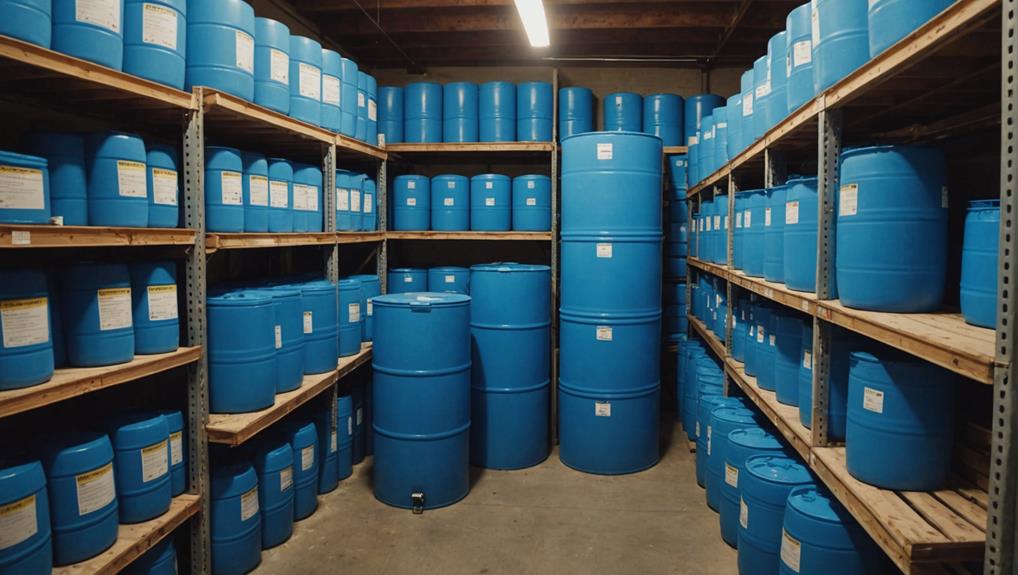
Storing water effectively is essential for preppers, guaranteeing you have a reliable supply for drinking, cooking, and hygiene. One of the best water storage solutions is using IBC totes, which can hold 275 gallons each. For a family of three, two IBC totes provide about 550 gallons of water, meeting your hydration needs for roughly 105 days. This is a practical and economical choice, priced between $65 and $100.
Alternatively, consider blue plastic barrels, which hold 42 gallons each. You can find these used for around $20 or new for about $55, making them a budget-friendly option for long-term storage. Whichever container you choose, confirm your water is disinfected using unscented bleach, especially if you're collecting rainwater.
Storing water isn't just about quantity; it's about quality, too. By following these tips, you can secure a safe, sustainable supply that supports your freedom and self-sufficiency. Make water storage a priority in your prepping strategy, and you'll be better equipped to face any challenges that come your way. Remember, proper hydration is key to survival and well-being!
Nutritional Considerations
Focusing on nutritional considerations is essential for preppers, ensuring you have the right foods to maintain health and energy during emergencies. To achieve this, prioritize high-caloric density foods, like beans and legumes, for their nutritional value and long shelf life. Aim for a diverse food storage to provide balanced meals, enabling you to stay strong and energized.
Here's a quick reference table to guide your choices:
| Food Type | Nutritional Benefits |
|---|---|
| Beans | High in protein and fiber |
| Whole Grains | Rich in complex carbohydrates |
| Canned Vegetables | Provide essential vitamins |
| Nuts and Seeds | Healthy fats and protein |
| Freeze-Dried Foods | Long shelf life, retaining nutrients |
When selecting shelf-stable items, seek those with a minimum shelf life of one year. Don't forget to reflect on dietary restrictions and preferences, ensuring every family member has access to nutritious options. Including vitamin and mineral supplements can help fill in any nutritional gaps during those challenging times. Remember, proper food storage isn't just about quantity; it's about quality too.
Organizing Your Pantry
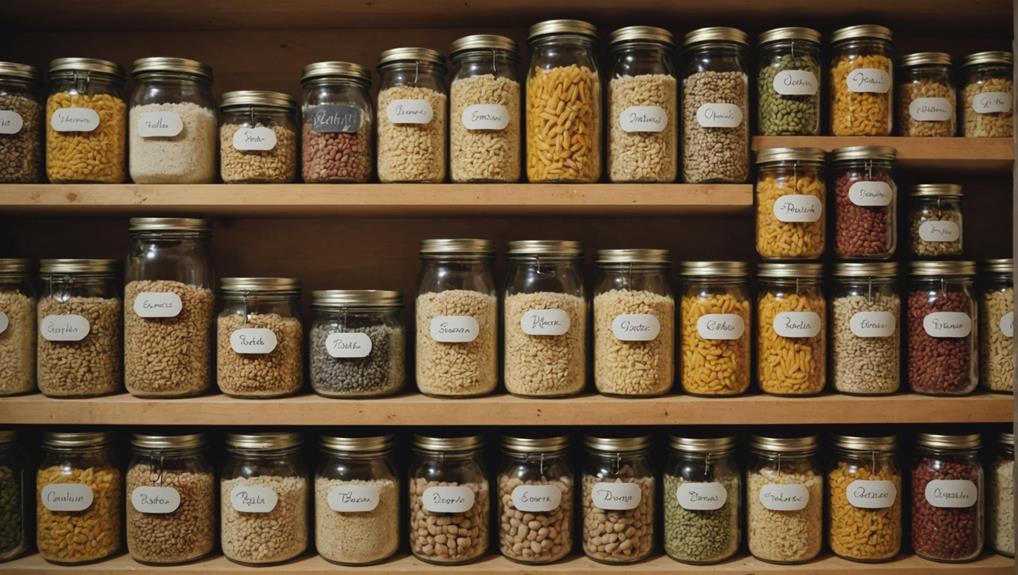
Organizing your pantry can make a significant difference in how efficiently you access and use your food supplies during an emergency. Start by evaluating your household's food needs and preferences to create a tailored list of essential items for storage. Group similar items together—think grains, canned goods, and snacks—so you can easily find what you need when it counts.
Implement a First In, First Out (FIFO) system to keep your food fresh. This means using older items first, minimizing waste, and ensuring your supplies remain usable. Regularly check expiration dates on non-perishable items to maintain safety and quality.
Consider using clear containers or labeling your pantry contents. This enhances organization and lets you quickly monitor stock levels, ensuring you're always prepared. A well-organized pantry not only saves you time but also empowers you to make informed food choices when freedom matters most.
Cost-Effective Food Preservation
Finding cost-effective methods to preserve food can help you save money while ensuring a reliable supply of nutritious options for the future. Here are three strategies to evaluate:
- Buy One, Get One: Take advantage of sales on dry beans or other staples. Stocking up can cut costs and provide a long-term emergency food source.
- Home Canning: Preserve seasonal produce through canning. It's a budget-friendly way to enjoy fresh flavors year-round while reducing waste.
- Oxygen Absorbers: Use oxygen absorbers in mylar bags to extend the shelf life of your food stores. This simple step can keep dry goods fresh for up to 30 years, giving you peace of mind.
Long-Term Food Supply Goals

Setting clear long-term food supply goals guarantees you're prepared for any emergency while maintaining a nutritious and balanced diet. Aim to build up your pantry with a minimum of one month's worth of essential items, then gradually increase that to a full year's supply. This way, you'll have an Emergency Food Supply that keeps you and your loved ones safe and nourished during tough times.
Focus on diversity in your food choices. Incorporate grains, legumes, canned foods, and freeze-dried items to guarantee you get a balanced range of nutrients. Don't forget to set specific goals for crucial protein sources and essential vitamins and minerals, which will support your health over the long time.
Regularly review your food storage and update it based on your household's changing needs. You want to make certain everything is still safe to eat and within expiration dates. Consider long-term storage solutions like bulk purchasing and mylar bags with oxygen absorbers to extend your food's shelf life, sometimes up to 30 years. With these goals, you'll have the freedom to thrive, no matter what challenges come your way.
Frequently Asked Questions
How Do You Store Food for a Long Shelf Life?
To store food for a long shelf life, vacuum seal items, use mylar bags with oxygen absorbers, and consider freeze drying. Keep your pantry organized to easily access and rotate your supplies when needed.
What Is the Longest Lasting Prepper Food?
The longest lasting prepper food includes freeze-dried meals and dehydrated fruits. Vacuum sealing canned vegetables and practicing proper grain storage can also extend shelf life, giving you the freedom to prepare for any situation.
What Is the Best Food to Stockpile?
When stockpiling food, focus on canned vegetables, freeze-dried meals, bulk grains, and protein sources. Don't forget dehydrated fruits; they'll keep you nourished and satisfied during tough times, ensuring your freedom and resilience.
How Do You Jar Food for Long Term Storage?
To jar food for long-term storage, use canning techniques for proper jar sealing. Combine vacuum sealing with these methods for maximum nutrient retention, ensuring your preserved food stays fresh and ready for whenever you need it.
Conclusion
In summary, long-term food storage is essential for any prepper looking to guarantee their family's safety and well-being. By understanding the importance of various food types, employing smart shopping strategies, and mastering effective storage techniques, you'll be well-prepared for any situation. Don't forget to prioritize water storage and nutritional value while organizing your pantry. With these tips, you can confidently build a cost-effective food supply that meets your long-term goals. Stay prepared and stay safe!
As an Amazon Associate I earn from qualifying purchases.
